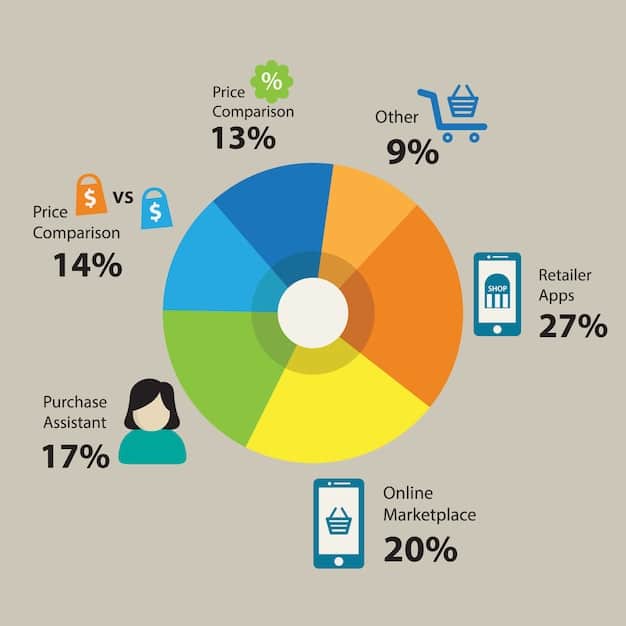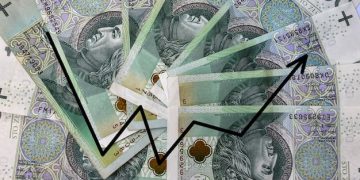CPI Rises 0.4% in November: Inflation Concerns Continue Unabated

The Consumer Price Index (CPI) rose by 0.4% in November, signaling persistent inflationary pressures that continue to challenge household budgets and central bank policy, extending concerns over economic stability and purchasing power across the United States.
The latest economic data reveals a crucial shift in the landscape of American household finances. The Bureau of Labor Statistics recently announced that the Consumer Price Index Rises 0.4% in November – Inflation Concerns Continue, sparking renewed debate and anxiety among consumers and financial experts alike. This marginal yet impactful increase directly affects the cost of everyday goods and services, prompting questions about the implications for purchasing power and economic stability.
Understanding the Consumer Price Index (CPI) and Its November Surge
The Consumer Price Index (CPI) serves as a vital economic indicator, providing a comprehensive measure of the average change over time in the prices paid by urban consumers for a market basket of consumer goods and services. Its recent 0.4% increase in November has not only caught the attention of economists but has also fueled ongoing inflation concerns among the general public. This segment delves into what the CPI represents, how it’s calculated, and the immediate implications of its latest upward movement.
The CPI is formulated by the Bureau of Labor Statistics (BLS) and acts as a primary gauge of inflation, reflecting the cost of living for millions. It tracks price changes for a vast array of items, from food and energy to housing and healthcare. When the CPI rises, it indicates that consumers are paying more for the same basket of goods and services, effectively reducing their purchasing power. This subtle but significant shift in November underscores that inflationary pressures persist, despite previous expectations or monetary policy interventions.
Key Components Driving the November Increase
Several categories within the CPI contributed to the 0.4% rise, demonstrating that inflation is not isolated to one sector but rather a broad economic phenomenon. Understanding these driving forces is crucial for a complete picture of the current economic climate.
- Housing Costs: Shelter, which includes rent and owners’ equivalent rent, remains a significant contributor to inflation. Elevated demand and supply constraints continue to push housing expenses upwards, impacting a large portion of household budgets.
- Energy Prices: While volatile, energy costs, particularly gasoline and utilities, occasionally exhibit sharp increases, directly translating to higher transportation and living expenses for consumers.
- Food Prices: The cost of groceries and dining out has been a consistent concern, with supply chain issues, labor shortages, and global events contributing to sustained upward pressure on food prices.
The Broader Economic Impact of Rising CPI
The implications of a rising CPI extend far beyond individual household budgets. It influences monetary policy decisions by the Federal Reserve, affects wage negotiations, and can even reshape consumer spending habits and investment strategies. A continuous upward trend in inflation can erode savings, make future planning difficult, and potentially slow down economic growth if left unchecked. The November data signals that these broader economic challenges are far from over, requiring careful monitoring and strategic responses from both policymakers and consumers. This persistent upward pressure on prices highlights the complexities of managing a modern economy where various factors intertwine to affect the financial well-being of its citizens.
Dissecting the Factors Fueling Persistent Inflationary Pressures
The continuous rise in the Consumer Price Index is not a singular event but rather a culmination of complex, interconnected economic forces. Examining these underlying factors is essential to comprehend why inflation concerns endure, even as policymakers strive for stability. This section explores the primary drivers behind the seemingly intractable inflationary trend observed in the economy, providing a deeper understanding beyond mere percentages.
One significant factor has been the lingering effects of global supply chain disruptions. Initiated by the pandemic, these disruptions continue to create bottlenecks, raising production costs and leading to higher prices for consumers. Manufacturers face increased expenses for raw materials, shipping, and labor, which are then passed on to the final consumer. This “cost-push” inflation mechanism is a powerful force, as businesses aim to maintain profit margins in an environment where inputs are more expensive and harder to acquire reliably. The fragile nature of international logistics means that even minor setbacks can cause disproportionate price hikes, affecting everything from electronics to consumer goods.
Labor Market Dynamics and Wage Growth
The tightness of the labor market also plays a crucial role in perpetuating inflation. With unemployment rates remaining low, businesses often struggle to find and retain workers, leading to upward pressure on wages. While wage growth can be beneficial for workers, if it outpaces productivity gains, it can contribute to a “wage-price spiral” where rising wages lead to higher production costs, which in turn lead to higher prices, prompting demands for even higher wages. This cycle can be particularly difficult to break once established, as workers seek to maintain their purchasing power amidst rising living costs, and businesses respond by increasing prices to cover their elevated labor expenses.
Furthermore, strong consumer demand, often fueled by accumulated savings or government stimulus programs, has contributed to “demand-pull” inflation. When consumers have more money to spend, and there is a high desire for goods and services, businesses can raise prices without a significant drop in demand. This scenario creates an environment where price increases are readily accepted, allowing inflation to take root and persist. The resilience of consumer spending, despite general economic anxieties, indicates that this demand-side pressure remains a potent factor in the ongoing inflationary narrative, requiring a delicate balance from economic policymakers who must weigh the benefits of growth against the risks of overheating.
Lastly, geopolitical instability and unexpected global events, such as conflicts or commodity price shocks, can have a rapid and substantial impact on inflation. For instance, disruptions in energy markets or the supply of critical raw materials due to international tensions can immediately translate into higher prices worldwide. These external shocks are often unpredictable and challenging for central banks to manage, adding another layer of complexity to the fight against inflation. Their immediate and far-reaching effects underscore the interconnectedness of the global economy and how events in one region can ripple across the entire economic landscape, making the task of price stability increasingly difficult.

Impact on Household Budgets and Purchasing Power in America
The persistent rise in the Consumer Price Index has tangible and often immediate consequences for household budgets across America. When the cost of living increases, families find their purchasing power diminishing, meaning their current income buys less than it did before. This erosion of purchasing power is a central concern for millions of Americans, as it directly impacts their ability to maintain their standard of living, save for the future, and meet daily financial obligations. Understanding how this process unfolds is crucial for grasping the personal finance challenges brought about by inflation.
For many households, the most visible impact comes from essential expenditures. Categories such as groceries, gasoline, and utilities are non-negotiable for daily life, and price increases in these areas are felt acutely. Families might find themselves allocating a larger portion of their income to these necessities, leaving less disposable income for discretionary spending, savings, or investments. This shift can force difficult choices, such as cutting back on entertainment, travel, or even delaying significant purchases like vehicles or home improvements. The cumulative effect of these small sacrifices can significantly reduce overall quality of life, placing considerable stress on household finances and planning.
Stratified Impact Across Income Levels
The impact of inflation is often not evenly distributed across all income levels. Lower-income households tend to be disproportionately affected because a larger percentage of their income is typically spent on essential goods and services, which are often the first to see price hikes during inflationary periods. These families have less flexibility in their budgets to absorb rising costs, making them more vulnerable to the erosion of purchasing power.
- Fixed Income Earners: Retirees and individuals on fixed incomes are particularly vulnerable, as their income does not adjust upwards to match rising prices, leading to a direct reduction in their real income.
- Wage Earners: For those whose wages do not keep pace with inflation, their effective earning power decreases over time. While some sectors may see wage growth, it often lags behind the rate of inflation, creating a continuous uphill battle for consumers.
- Savers: Inflation erodes the real value of savings. Money held in traditional savings accounts or under the mattress loses its purchasing power over time, making it harder to accumulate wealth or achieve long-term financial goals.
Adjusting to the New Economic Reality
As inflation persists, consumer behavior adapts. People start prioritizing spending, searching for cheaper alternatives, or reducing consumption of non-essential items. This behavioral shift can have broader economic implications, as reduced consumer spending can slow down economic growth in the long run. Many households are now actively seeking strategies to mitigate the effects of inflation, such as budgeting more strictly, looking for discount opportunities, or even taking on part-time jobs to supplement income. The struggle to adapt to the new economic reality underscores the profound and multifaceted ways in which inflation directly touches the lives of everyday Americans, making financial planning a more complex and urgent task.
The Federal Reserve’s Stance and Future Monetary Policy
The Federal Reserve plays a pivotal role in managing inflation, primarily through its monetary policy tools. With the Consumer Price Index continuing its upward trajectory, recording a 0.4% increase in November, the spotlight remains firmly on the Fed’s strategy and its potential actions. The central bank’s dual mandate includes achieving maximum employment and maintaining price stability. The persistent inflation challenges the latter, compelling the Fed to assess its approach and consider aggressive measures to cool down the economy without triggering a recession.
Historically, the Federal Reserve responds to inflationary pressures by raising interest rates. Higher interest rates make borrowing more expensive, which can cool down consumer demand and business investments, thereby reducing inflationary pressures. The recent CPI data serves as strong evidence that while previous rate hikes may have had some impact, they haven’t been sufficient to bring inflation back to the Fed’s long-term target of 2%. This situation places the Fed in a delicate position, balancing the need to control inflation with the risk of stifling economic growth and potentially leading to higher unemployment.
Navigating a Complex Economic Landscape
The Fed’s decision-making process is complicated by several factors. Global economic uncertainties, fluctuating energy prices, and ongoing supply chain issues are largely beyond the direct control of monetary policy but significantly influence domestic inflation. The Fed must analyze these external variables alongside domestic economic indicators to formulate an effective strategy.
- Forward Guidance: The Fed’s communication regarding its future policy intentions (forward guidance) is critical in managing market expectations and investor behavior. Clear signals about potential rate hikes or pauses can influence borrowing costs and investment decisions.
- Quantitative Tightening: Beyond interest rates, the Fed’s balance sheet reduction (quantitative tightening) also impacts the economy by withdrawing liquidity. This process aims to normalize financial conditions and further exert downward pressure on inflation.
- Data Dependency: The Fed remains highly data-dependent, meaning its decisions hinge on the continuous assessment of economic reports, including not just inflation data but also employment figures, wage growth, and consumer spending patterns.
Looking ahead, financial markets and the public will closely monitor the Federal Reserve’s statements and actions. The November CPI report reinforces the expectation that the Fed may need to maintain a hawkish stance for longer than previously anticipated, or even consider further interest rate increases, to decisively combat inflation. Any aggressive moves, however, carry the risk of slowing economic activity more than intended, highlighting the significant challenge ahead for monetary policymakers in steering the economy towards a path of sustainable growth and price stability without inducing undue hardship or a significant downturn. The ongoing struggle against inflation underscores the complexity and high stakes involved in central banking today.
Consumer and Business Sentiments Amidst Rising Costs
The continuous rise in the Consumer Price Index (CPI), highlighted by its 0.4% increase in November, has predictably cast a shadow over both consumer and business sentiments. These sentiments are crucial indicators of economic health, influencing spending patterns, investment decisions, and overall economic activity. When inflation concerns persist, they directly impact how individuals perceive their financial future and how businesses plan for growth and profitability. This section delves into the evolving psychology of consumers and businesses in an inflationary environment, uncovering the strategies they adopt to cope with rising costs and the broader implications for the economy.
For consumers, the immediate reaction to persistent inflation is often a mix of anxiety and adaptation. There’s a tangible fear of declining purchasing power—the worry that their hard-earned money simply won’t go as far. This can lead to a shift in spending habits, with a greater emphasis on essential goods and a reduction in discretionary purchases. Consumers may become more price-sensitive, actively seeking out discounts, planning meals more carefully, and deferring non-urgent expenditures. This cautious approach to spending reflects a defensive posture against the erosion of savings and the increasing cost of living, fundamentally altering the dynamics of demand in the economy.
Business Responses to Inflationary Pressures
Businesses, on the other hand, face a dual challenge: managing increased input costs while trying to avoid alienating price-sensitive consumers. Their responses to inflation often involve a combination of strategies designed to maintain profitability and market share.
- Price Adjustments: Many businesses are forced to raise their prices to cover higher costs of raw materials, labor, and transportation. This can be a delicate balancing act, as too steep an increase might deter customers.
- Efficiency Improvements: Companies often seek ways to enhance operational efficiency, such as optimizing supply chains, investing in automation, or renegotiating supplier contracts, to mitigate cost pressures without passing all of them onto the consumer.
- Product Shifting or Downsizing: Some businesses might introduce smaller package sizes for the same price (“shrinkflation”) or offer more affordable product lines to cater to budget-conscious consumers, allowing them to indirectly adjust to the rising operational costs.
The interplay between consumer caution and business adaptation creates a dynamic and often unpredictable economic environment. While some businesses may thrive by offering value or by being in sectors less affected by inflation, others may struggle with declining demand and compressed margins. This ongoing adjustment period highlights the critical need for both consumers and businesses to remain agile and proactive in their financial planning and strategic decision-making. The sustained inflationary pressures mean that these sentiments and adaptive behaviors are unlikely to dissipate quickly, shaping the economic landscape for the foreseeable future and influencing long-term recovery efforts, underscoring the broad psychological impact of price instability on economic agents.
Historical Context: How Current Inflation Compares to Past Cycles
To truly appreciate the significance of the Consumer Price Index rising 0.4% in November and the enduring inflation concerns, it’s beneficial to place the current situation in historical context. Comparing today’s inflationary environment to past cycles provides valuable insights into potential trajectories, policy responses, and the long-term impact on the economy. While every inflationary period is unique, historical precedents often offer a framework for understanding the complexities involved.
The most frequently cited comparison is with the high-inflation era of the 1970s and early 1980s. During that period, deeply entrenched inflation was fueled by a combination of oil shocks, expansionary fiscal policies, and a loose monetary stance from the Federal Reserve. Inflation soared to double-digit figures, leading to prolonged economic stagnation coupled with high unemployment—a phenomenon known as “stagflation.” The current inflationary surge shares some characteristics, such as supply chain issues and energy price volatility, but generally lacks the same degree of wage-price spiral and persistent inflationary expectations observed in the 70s. Modern central banks are arguably more attuned to managing inflation expectations, drawing lessons from that era to prevent a similar prolonged episode.
Differences and Similarities in Inflationary Triggers
While the 1970s saw inflation primarily driven by supply shocks and a reactive monetary policy, the current cycle has been largely influenced by the unprecedented global demand shifts and supply disruptions stemming from the pandemic, followed by geopolitical events.
- Supply Chain Disruptions: Unlike past cycles dominated by geopolitical oil crises, today’s supply challenges are far broader, affecting a wide range of goods from semiconductors to consumer products, acting as a major bottleneck.
- Fiscal Stimulus: The scale of fiscal stimulus during the pandemic was also unique, injecting significant purchasing power into the economy, thereby driving demand-pull inflation in a way not seen in previous, more traditional business cycles.
- Monetary Policy Action: Compared to the slow response in the 70s, central banks globally have acted more swiftly in raising interest rates, albeit perhaps not as aggressively as some critics would prefer. This proactive stance aims to curb inflation before it becomes deeply embedded in expectations.
Another relevant comparison can be made to the post-World War II period, where significant pent-up demand and supply constraints led to a temporary surge in prices. However, that period was followed by robust economic growth and a relatively quick normalization of inflation. Today’s situation may share the demand-pull aspect but is arguably more complex due to globalized supply chains and the pervasive impact of digital economies on price formation. Understanding these nuances underscores that while history offers lessons, current macroeconomic challenges require bespoke solutions. The current inflation period, therefore, represents a unique confluence of factors, demanding a nuanced approach from policymakers to achieve stability without stifling the nascent economic recovery, solidifying its place as a distinct chapter in the economic history of the nation.
Strategies for Coping with Continued Inflation
With the Consumer Price Index showing a 0.4% increase in November and inflation concerns continuing to weigh on the economy, individuals and businesses are increasingly seeking practical strategies to mitigate the impact of rising costs. Adapting to an inflationary environment requires proactive financial planning and smart decision-making to protect purchasing power and maintain financial stability. This section offers actionable advice on how to navigate ongoing price increases, providing both defensive and offensive measures to safeguard economic well-being.
For individuals, budgeting becomes more critical than ever. A precise understanding of income and expenses is the first step towards identifying areas where spending can be reduced or optimized. This might involve tracking every dollar spent, cutting back on non-essential purchases, or finding cheaper alternatives for regular expenses, such as cooking more at home instead of dining out. Exploring ways to increase income, whether through a side hustle, job training, or negotiating a raise, can also offset the erosive effects of inflation on purchasing power. The focus shifts from merely accumulating wealth to preserving its real value in the face of rising prices, making every financial decision more impactful.
Investing and Saving in an Inflationary Climate
Strategic investment choices can also play a crucial role in protecting assets from inflation. Traditional savings accounts often yield returns lower than the inflation rate, meaning money held in them loses value over time.
- Inflation-Protected Securities: Treasury Inflation-Protected Securities (TIPS) are designed to adjust their principal value based on inflation, offering a direct hedge against rising prices.
- Real Assets: Investments in real estate, commodities, or gold can retain or increase their value during inflationary periods because their value is tied to tangible goods rather than financial instruments.
- Equities: Investing in companies with strong pricing power—those that can pass on increased costs to consumers without losing sales—can also be an effective strategy, as these businesses may continue to perform well.
Businesses, too, must adopt robust strategies to cope with inflation. This involves meticulous cost management, exploring hedging strategies for raw materials, and continually evaluating pricing models to reflect rising expenses. Investing in productivity-enhancing technologies can also help offset increased labor costs, maintaining competitiveness without significantly raising prices. Building stronger relationships with suppliers to secure favorable terms and diversifying supply chains can also reduce vulnerability to price shocks. For both consumers and businesses, the ability to adapt, innovate, and make informed financial decisions will be paramount in navigating the persistent inflationary pressures. These comprehensive strategies are not just reactive measures but proactive steps towards fostering greater financial resilience in an unpredictable economic landscape, ensuring sustainability amidst continued market volatility and upward pricing trends.
Navigating Policy Responses and Economic Outlook in 2025
As the Consumer Price Index registered a 0.4% rise in November, intensifying inflation concerns, the economic outlook for 2025 heavily hinges on the efficacy of ongoing and future policy responses. The past year has demonstrated the complexity of reining in inflation without stifling economic growth, a challenge that will undoubtedly persist. This section explores potential policy directions, their anticipated effects, and the broader economic outlook as we approach the mid-point of the decade, acknowledging the delicate balance required from central banks and governments alike.
Central banks, primarily the Federal Reserve in the U.S., are expected to continue their data-dependent approach to monetary policy. This implies that future interest rate decisions will closely track inflation trends, employment figures, and global economic developments. If inflation persists above target, further rate hikes are likely, though perhaps at a slower pace to avoid pushing the economy into a deep recession. Conversely, a significant and sustained drop in inflation could pave the way for rate cuts, offering some relief to borrowers and stimulating investment. The primary goal remains achieving a “soft landing”—cooling inflation without causing substantial economic contraction, a notoriously difficult feat.
Government Fiscal Policy and its Role
Beyond monetary policy, governmental fiscal policy will also play a crucial role in shaping the 2025 economic landscape. Measures such as tax policies, government spending on infrastructure, and social programs can either exacerbate or alleviate inflationary pressures.
- Targeted Spending: Governments may opt for targeted spending initiatives that address supply-side bottlenecks, such as investments in logistics or energy production, which could help reduce costs and ease inflationary pressures.
- Fiscal Prudence: A move towards fiscal consolidation (reducing budget deficits) could also help dampen aggregate demand, thereby contributing to the fight against inflation, but this needs to be balanced against potential impacts on social welfare programs.
- Regulatory Frameworks: Policy adjustments to regulatory frameworks, particularly in sectors prone to price volatility like energy or housing, could also be considered to foster greater competition and supply, leading to more stable prices over time.
The economic outlook for 2025, therefore, is one of cautious optimism mixed with persistent uncertainty. While inflation is expected to gradually moderate from its peak, significant headwinds remain, including geopolitical tensions, the ongoing adjustment of global supply chains, and the evolving dynamics of labor markets. Policymakers face the challenging task of calibrating their responses to these multifaceted pressures while striving for long-term economic stability and growth. The success of these policy responses will ultimately determine the trajectory of inflation, the robustness of economic recovery, and the financial well-being of households and businesses alike, making the coming year a critical period for economic management and strategic adaptation across the board, setting precedents for future economic stability.
The consistent rise in the Consumer Price Index in November underscores a critical juncture for the U.S. economy, where inflationary pressures remain a dominant concern for policymakers and everyday citizens. Understanding these complex economic forces is key to navigating the challenges ahead.
| Key Point | Brief Description |
|---|---|
| 📊 CPI Rise | Consumer Price Index increased by 0.4% in November, signaling persistent inflation. |
| 💸 Purchasing Power | Rising CPI erodes household purchasing power, impacting essential spending. |
| 🏦 Fed’s Response | Federal Reserve likely to maintain tight monetary policy to combat inflation. |
| 💡 Coping Strategies | Budgeting, strategic investing, and efficiency are key for individuals and businesses. |
Frequently Asked Questions About Inflation
A 0.4% rise in the Consumer Price Index (CPI) means that the average cost of goods and services increased by that percentage in November. For everyday consumers, this translates to a slight decrease in purchasing power, as their money buys fractionally less than it did before, affecting the affordability of essentials like groceries and fuel.
Current inflation, while elevated, is generally less severe than the double-digit rates seen in the 1970s. That era was marked by prolonged stagflation, fueled by oil shocks and loose monetary policy. Today’s inflation is more influenced by pandemic-related supply chain issues and robust demand, with more proactive central bank responses.
To protect savings from inflation, individuals can consider investing in inflation-protected securities like TIPS, real assets such as real estate or certain commodities, or equities of companies with strong pricing power. Diversifying investments and exploring accounts with higher interest rates can also help mitigate loss of purchasing power.
The Federal Reserve uses interest rates to combat inflation by making borrowing more expensive. Higher rates discourage consumer spending and business investment, thereby reducing overall demand in the economy. This slowdown in demand helps to cool down prices and bring inflation closer to the central bank’s target rate, aiming for economic stability.
Yes, governments can intervene with fiscal policies to address inflation by adjusting spending and taxation. Targeted spending on supply-side issues, such as infrastructure, can boost productivity and reduce costs. Fiscal prudence, like reducing budget deficits, can also help dampen demand. These actions complement monetary policy in managing inflationary pressures.
Conclusion
The November CPI report, confirming a 0.4% increase, serves as a stark reminder of the ongoing battle against inflation. This persistent challenge affects every American household, demanding vigilance from consumers and strategic action from policymakers. As we move forward, understanding the interplay of global supply chains, consumer demand, and monetary policy will be crucial in navigating these economic waters toward greater stability and prosperity for all.





